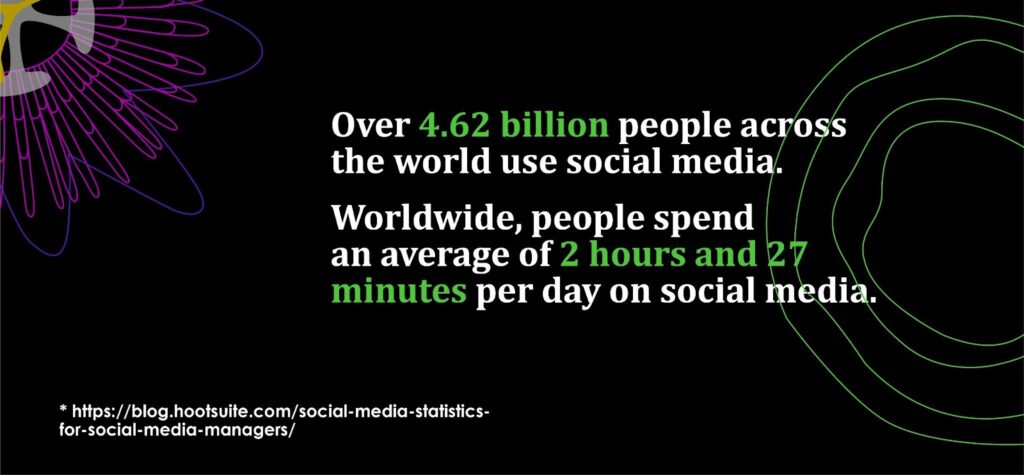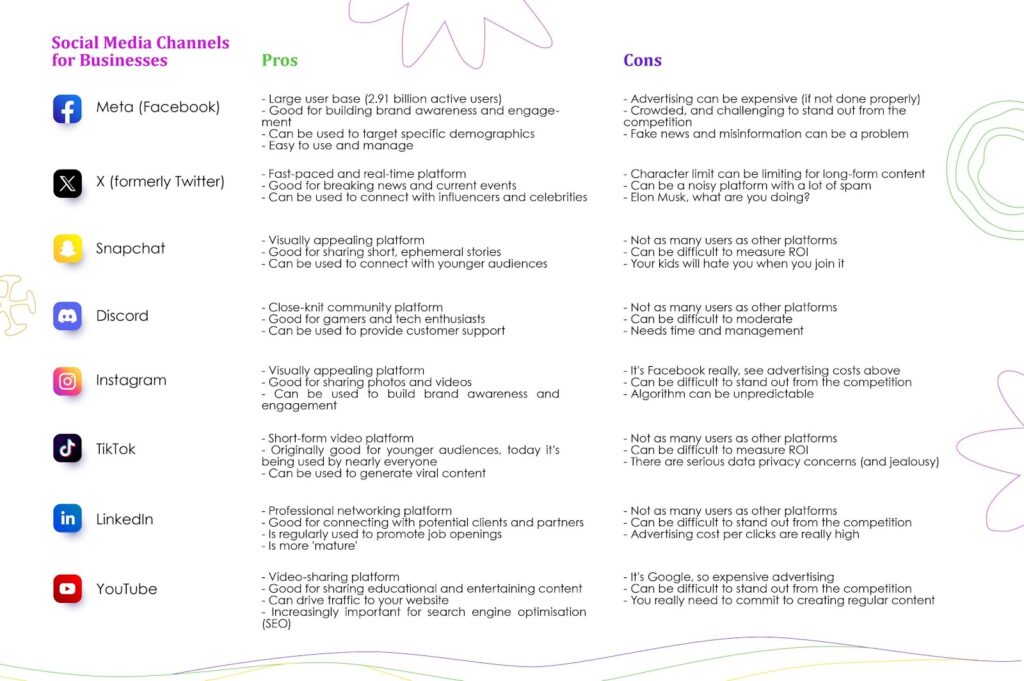Social Media for Business, Where Do You Start?
Nerd Digital looks at the different social media channels and the best ways to make the most of them, and what’s likely to work on each platform.
With 4.62 billion people using social media for more than two hours a day, the chances are you’ve regularly experienced at least one of its platforms – be that for business or pleasure. Now, one of the first questions we get asked by clients who are launching a product, service, campaign or new business is…
Which social media channels should we use?
Now – more often than not – this question actually translates to:
Which social media is best for making money?
So, at this point – after a quick wink and a nod – we get down to developing a winning social media strategy to find new customers, sell more product, and promote client events etc.
Different businesses will use different social media platforms depending on what their company is offering its customers. In this blog we will give you the low down on the key channels, their basic features and benefits, and some of Nerd’s social media agency tips that we’ve learned along the way.
Most people we speak with rarely have the time for social media (which is why they call us), but for those who master it, the rewards are huge.

Social Media for Business
Nowadays, we are up to our eyes in different social media platforms, with each one being handy for different things and all of them having algorithms that work in their own unique way. There are, for example, Facebook, LinkedIN, Twitter* X, YouTube, and Instagram – each of which are the most popular for businesses. And then there are platforms such as TikTok that are growing in popularity amongst companies that may be looking for more of an online presence or trying to connect with a younger audience.
Recently, Instagram launched Threads, a simplified version of Twitter. However, Threads is not a must-have for businesses unless there is a demand for it among your customers. In essence, Threads is just Twitter with fewer features.
Not all companies will need to use every platform – use what works for you. There is no need to complicate things and put yourself on platforms your customers don’t use. We always advise our clients to select one platform first and get GOOD at that, before spreading themselves too thinly.
*sorry, we’re not fans of the new Twitter name/letter/mark – in fact there’s a very good joke about this … Why is it that every bird Elon Musk touches turns into an X?!
The most popular Social Media platforms – what works best?
Each platform has certain content that works best. The following infographic gives the pros and cons, with the key points below that:

X (Formerly known as Twitter)
With a platform like X, companies can share everything and that’s why it can be such a popular choice for people to use and to promote their business. Short-form videos work well and you ideally want the video to be no more than 30 seconds – any longer and (unless you have premium) you may struggle to upload the video. Posts with images do well compared to posts without so it’s always worth having an image to go with your post.
Instagram is becoming less about imagery and more towards short-form video content. This doesn’t mean that you shouldn’t upload images to Instagram because ultimately that is still its main purpose – an image-sharing platform. But short-form video content is starting to be recognised by its algorithms. This is clear from the many re-uploads of TikToks you can find on Instagram.
Another example of Instagram taking a liking to videos is the addition of Reels, which again are simply more short-form videos around the 30-second time frame. However, unlike X, Instagram Reels can be more than a minute long without you having to pay any money.
TikTok
Possibly the most popular social media platform at the moment with everyone and their nan using the platform. Once again, we are talking about short-form video content. Unlike X or LinkedIn for example, TikTok is best for the more informal, jokey content. You are more likely to get a higher view count on videos that are ‘silly’ in nature rather than a serious video. But a big part of TikTok is trends and, done right, you can have a very successful week on this platform. Social media trends come and go, from Wes Anderson to Pedro Pascal eating a sandwich… it can simply switch overnight and you can never be quite sure what’s next but it’s always worth keeping an eye on what starts becoming popular.
But the key with all these platforms – hashtags. Without the proper hashtags on a post you are unlikely to find your audience. This is especially important if your company fits a very specific niche of people.
An example of where hashtags can be important in social media is in sports social media specifically – for example, when tweeting as a football club, the hashtags are very important and can be a kind of identity for the club. All football clubs will have their own hashtags from the bottom of the Non-League pyramid up to the best teams in the world.
Just remember – hashtags are important!
Snapchat – to use or not to use?
When it comes to using social media platforms and spreading the word about your business, it’s unlikely that you would have considered using Snapchat – which is a fair point considering the average age of people who use it.
According to The Social Shepherd – 77% of users on Snapchat are aged between 18-24.
Age isn’t the only issue when it comes to using Snapchat for your business – another problem you may run into is the length of videos and how long your content is viewable because Snapchat videos and photos last just 24 hours.
But if you do decide to use Snapchat, a ‘Public Profile’ that allows users to build a more (as the name suggests) public profile would arguably be the better option for businesses as it would allow them to store content on the app more easily.
For a business looking to expand, Snapchat might not be the best route to go down unless your audience and clientele use it regularly and are in the target age range.
Regarding what works best on a platform like Snapchat, you want to follow similar guidelines to what you would do for TikTok – short and snappy videos.
Discord – good for gamers but what about your business?
We’re sure that when you think about Discord your mind will go to gamers or crypto or NFT investors … but can it be used for your business?
Discord – although classed as a social media platform – isn’t really used as one in the same way Snapchat or Instagram are for example. Discord is much more focused on the connectivity side of things.
Although yes you can message people via Instagram and Snapchat, they have other functions as well – content sharing. Discord, on the other hand, is more about connecting and speaking with people in a similar way you would do so on Zoom, for example.
You aren’t going to find success in promoting a business in Discord, but it could be a great way to connect and chat with a client about ideas, and maybe create one of the next BIG communities in your space.
LinkedIn – or Linked(Out)?
When it comes to the perfect social media platform for business, look no further than LinkedIn. The perfect platform to share your work, meet potential clients, and connect with people who can help your business in any way, shape, or form.
LinkedIn is a great organic way of growing an audience. Which is no surprise given that there are around 58-61 million businesses (based on articles from The Social Shepherd and Sprout Social) signed up to LinkedIn.
The best piece of advice we can give is to spend 15 minutes per day on LinkedIn, no more and no less. We took this advice from someone and landed one of our favourite client’s this way.
YouTube? You Choose…
You only need to make a YouTube channel for your business if it’s needed or wanted by your audience. YouTube is a great way to share long-form content; for example, filmed podcasts can do well on YouTube.
But much like a lot of other social media platforms, YouTube is giving a lot of time to short-form content – hence YouTube Shorts. This appears to be used in a similar way to TikTok. You are looking at 30-second clips, which you can churn out on a regular basis – you can even re-upload your TikToks onto YouTube Shorts and they can do just as well.
Facebook [not just for friends?]
Like every current social media platform at the moment, Facebook has also taken a liking to short-form video content, although Facebook has had short videos on its platform for a long time – so although not a new thing for Facebook it will likely have seen a surge in popularity that may have caused a change in the algorithm over time.
The good thing about sharing your business on Facebook is that the average age demographic of Facebooks users which ranges from 25-44.
With such a wide demographic, it shouldn’t be too hard to find an audience.
Conclusion
There are many different social media channels available for businesses to use. The best channels for your business will depend on your specific goals and target audience. It is important to experiment with different channels and see what works best for you. But get good at ONE first!
Key takeaways from Nerd’s social media for business blog:
- Right message, right audience: Use the right channels for your audience. Some platforms are better suited to certain types of businesses and audiences. For example, TikTok is a good platform for businesses that want to reach a younger audience, while LinkedIn is a good platform for businesses that want to connect with professionals.
- Be engaging: Create engaging content. Your content should be interesting, informative, and relevant to your audience. Use visuals, humour, and storytelling to capture attention and keep people engaged.
- #usegoodhashtags: Use hashtags strategically. Hashtags can help people find your content. When using hashtags, be sure to use relevant and popular hashtags that your target audience is likely to use.
- Be consistent: The key to success on social media is to be consistent with your posting. Post regularly and on a schedule that works for you.
- Can’t measure, can’t manage: It is important to track your results so you can see what is working and what is not. Use social media analytics tools to track your follower growth, engagement, and website traffic…and most importantly, return on investment.
By following these tips, you can use social media to reach your target audience, build brand awareness, and grow your business. Nerd manages social media and social media advertising campaigns for its clients, so get in touch if you have any questions or need our support.





